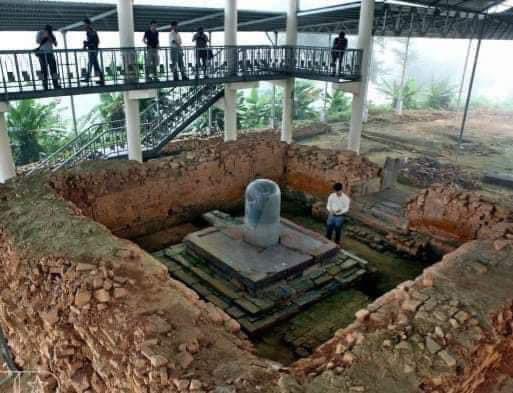
Significant Archaeological Discoveries in Vietnam: Ancient Shiva Lingas Unearthed
Vaishnavi Maripala
Two significant archaeological discoveries in Vietnam have brought to light the ancient presence of Hindu culture in the region, further cementing the historical and cultural ties between India and Vietnam.
Discovery at Cat Tien
At Cat Tien, an archaeological site located 150 kilometers from Ho Chi Minh City, recent excavations have uncovered a Shiva Linga measuring 2.27 meters in height. This artifact dates back to between the 4th and 9th centuries CE, indicating the presence of Hindu culture in Vietnam during this period. The Cat Tien site has long been of interest to archaeologists due to its potential to reveal insights into the region’s early cultural and religious history. The discovery of the Shiva Linga at this site underscores the historical presence of Hinduism in Vietnam, providing valuable insights into the region’s ancient cultural and religious landscape. This find is expected to prompt further research and exploration at Cat Tien and other related sites in Vietnam.

Discovery at Mỹ Sơn
In another remarkable discovery, the Archaeological Survey of India (ASI) unearthed a monolithic sandstone Shiva Linga from the 9th century CE during an ongoing conservation project at Mỹ Sơn. Mỹ Sơn, located in Quảng Nam province in central Vietnam, is a cluster of abandoned and partially ruined Hindu temples. This site, recognized as a UNESCO World Heritage Site, has long been a focus of conservation efforts due to its historical significance.
External Affairs Minister S. Jaishankar congratulated the ASI on their discovery, calling it “a great cultural example of India’s development partnership.” He highlighted that this artifact reaffirms the “civilizational connect” between India and Vietnam. The Shiva Linga discovered at Mỹ Sơn is expected to further enhance the understanding of the historical and cultural exchanges between the two countries.
Historical Context and Cultural Significance
The discoveries at Cat Tien and Mỹ Sơn are significant for several reasons. They not only provide evidence of the historical presence of Hinduism in Vietnam but also illustrate the cultural and religious exchanges that occurred between India and Southeast Asia over the centuries. These findings are crucial for understanding the extent and influence of Hindu culture in the region, shedding light on the ancient connections that shaped the cultural landscapes of both Vietnam and India.
Impact on Future Research
These discoveries are likely to spur further archaeological investigations and conservation efforts in Vietnam. Scholars and researchers will be keen to explore other potential sites that may hold similar artifacts, hoping to piece together a more comprehensive picture of Vietnam’s ancient past. The findings also emphasize the importance of international collaboration in the field of archaeology, as demonstrated by the partnership between Indian and Vietnamese authorities in uncovering and preserving these cultural treasures.
Conclusion
The unearthing of these ancient Shiva Lingas in Vietnam is a testament to the rich and diverse cultural history of the region. It highlights the enduring influence of Hindu culture and the historical ties between India and Vietnam. As research and conservation efforts continue, these discoveries will undoubtedly contribute to a deeper understanding of the cultural heritage shared by these two nations.


